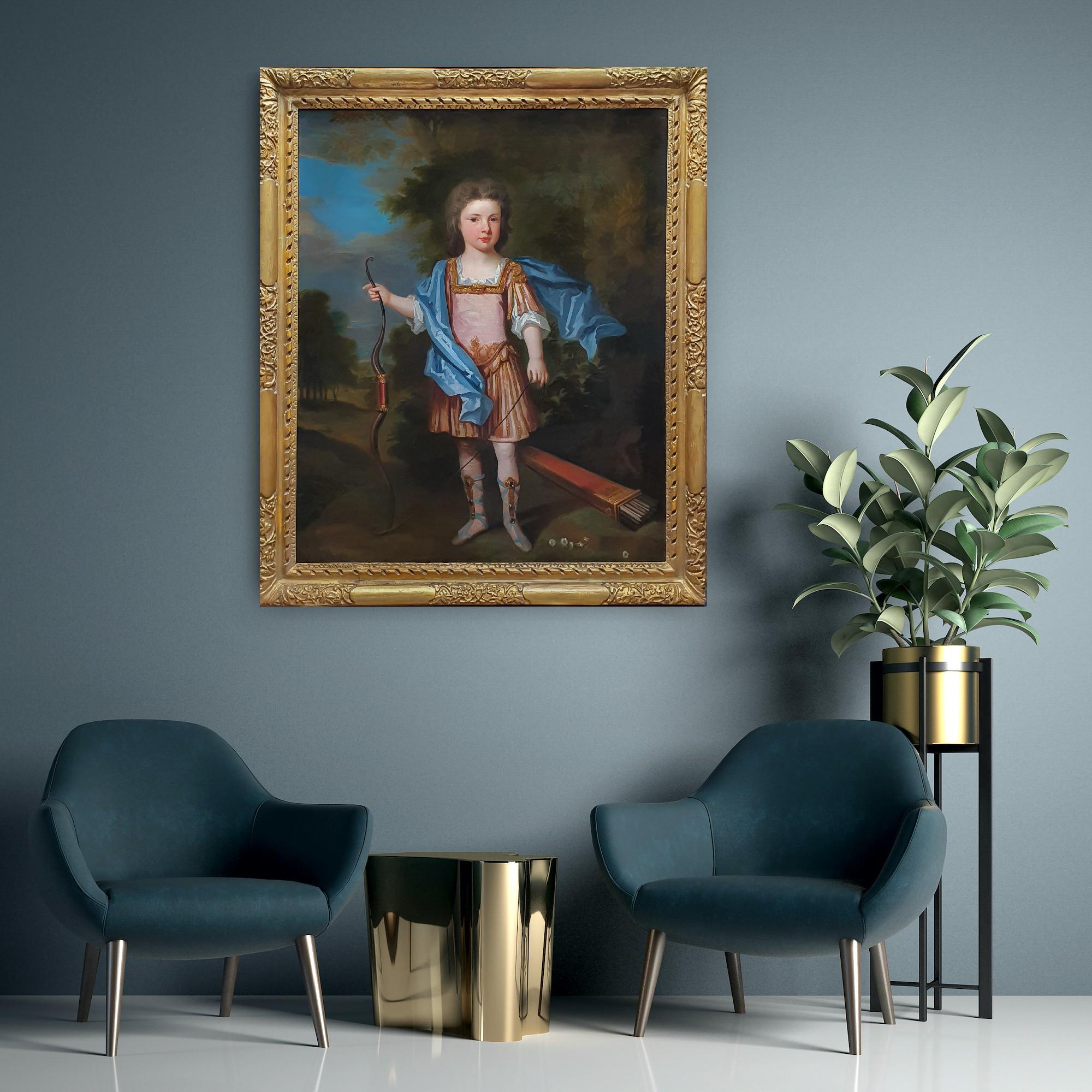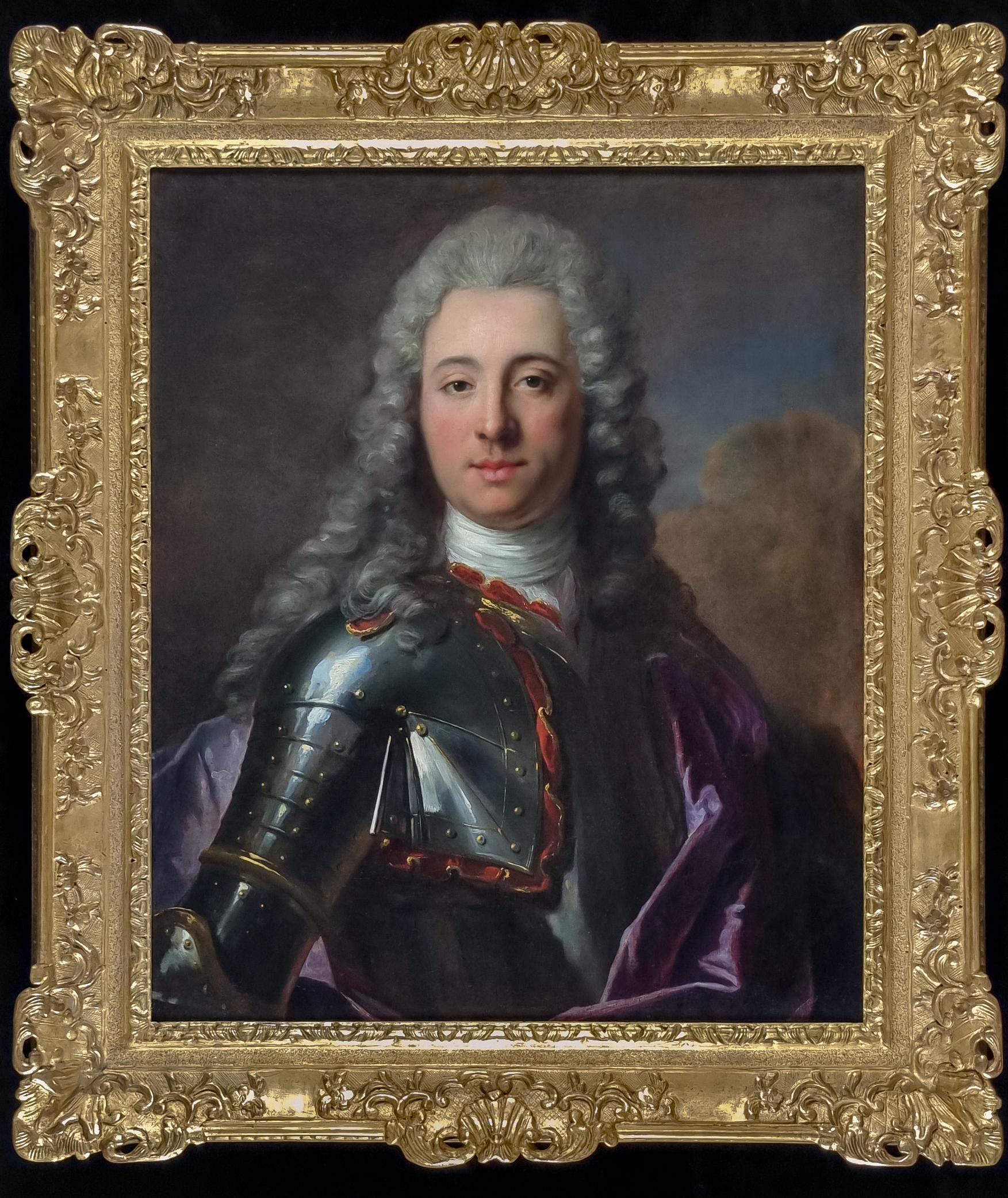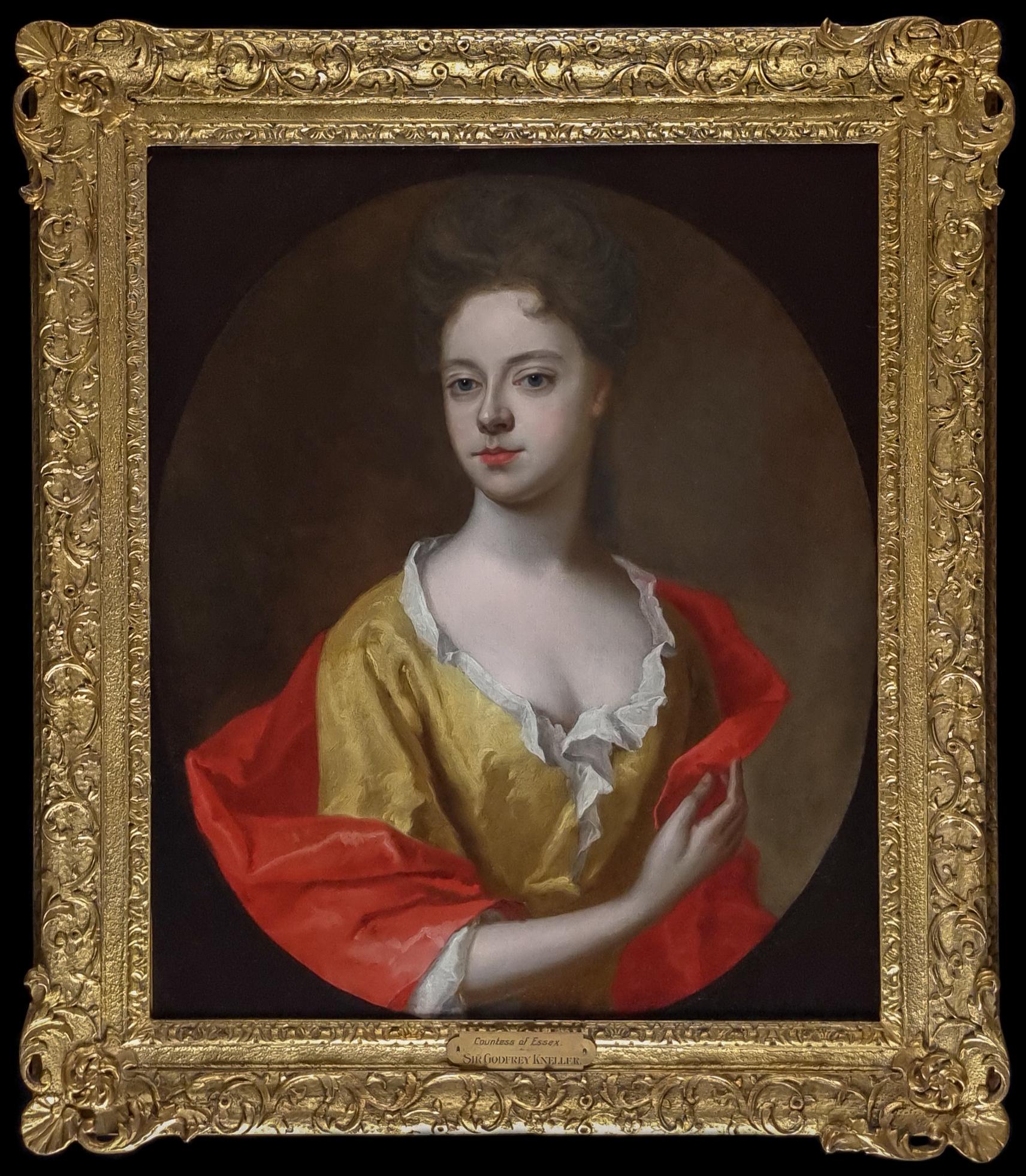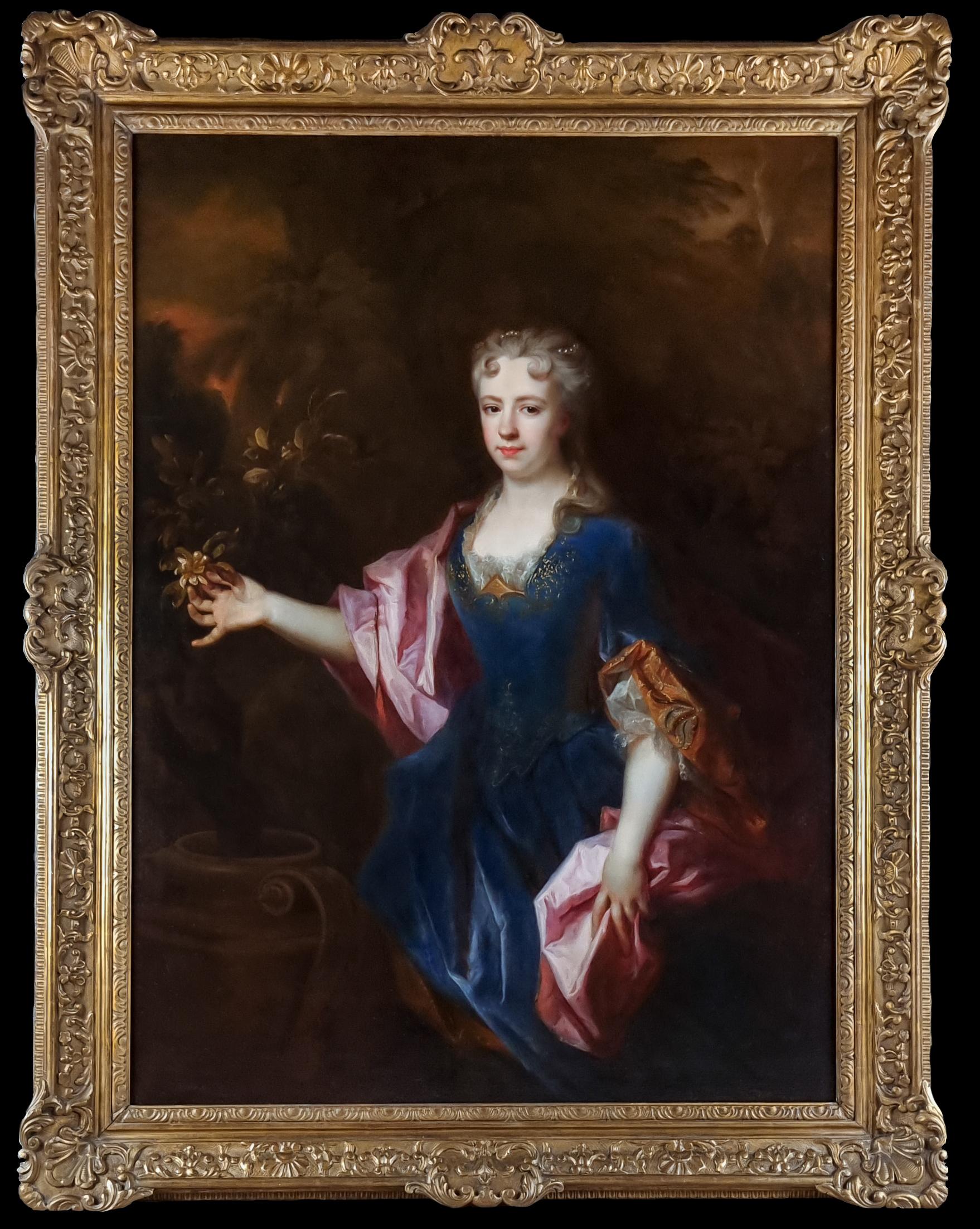Items Similar to Portrait of Lady Anne Tipping née Cheke c.1705, English Aristocratic Collection
Want more images or videos?
Request additional images or videos from the seller
1 of 16
Portrait of Lady Anne Tipping née Cheke c.1705, English Aristocratic Collectioncirca 1705
circa 1705
About the Item
Titan Fine Art present this exquisite portrait, that formed part of a historic collection of an English aristocratic family, Lord and Lady Sandys at their magnificent baroque and Regency Grade-I listed family home, Ombersley Court. The house was among the most fascinating survivals of its kind in this country. The atmospheric interiors were distinguished above all for the works of art associated with two key moments in national history and, more specifically, to the roles of Colonel the Hon. John Russell in the Civil War and the reign of King Charles II and of Lord Arthur Hill, later 2nd Baron Sandys, in the Peninsular War. The collection was acquired or commissioned over five centuries and remained at Ombersley Court until its recent sale, the first in 294 years. The full provenance of our painting, which hung in The Saloon (see photo), is known from its creation right through to now – an extraordinary fact considering its age.
This exquisite Grand Manner work is an evocative example of the type of portrait in vogue during the seventeenth and eighteenth centuries. Beautifully composed, the sitter has been depicted full length within surroundings that conveyed cultivation and an elite status – a classical porch with a colossal column. The beautiful colour combination of the azure silks of the dress, the mauve curtain and the sumptuous scarlet wrap imbue the portrait with a sense of luxury and emphasise the fact that this lady was a paragon of the wealthy and privileged society that she belonged to, with the means to commission a notable artist. Portrayed without the use of excessive props and jewellery, the artist knew that the sitter’s beauty was more than enough to captivate the audience. The clothing and hairstyle help to date the portrait to circa 1705. For any respectable woman at this time her skin is sheet white which was highly end vogue. A remarkable care is exercised in rendering of the flesh and the treatment of the drapery, with its delicate folds and virtuoso in the art of conveying the texture of the fabrics. The clear fresh palette, bright eyes, and rendering is exquisite.
On the lower right of the portrait is an identifying inscription: 'Lady Tipping / Daughter of Coll. Cheek'. Anne Tipping, née Cheke, was the daughter of Colonel Thomas Cheke (1628-1688) and his wife Letitia, née Russell (1649-1722). Her father was appointed Lieutenant of the Tower of London under King Charles II in 1679 and he held that position until 1687 when James II removed him from office. At the age of 22 Lady Tipping married Sir Thomas Tipping, 1st Bt. (1653-1718) with whom she had three children, Catherine, Letitia, and Thomas. Through her father, Anne inherited the manor of Pyrgom in the village of Havering-atte-Bower, Essex. The house had previously belonged to Henry VIII, and it was here that he made the decision to restore the princesses Mary and Elizabeth to the succession to the throne. In 1724, Anne helped to found the Dame Tipping school in Havering-atte-Bower, which was endowed from her death in 1728 by a legacy in her will. Anne was lucky to have independent means, as her husband led a tumultuous life, dying in debt in Southwark prison. Anne died when she was just forty-eight years of age and is buried at Havering.
Our sitter’s daughter, Letitia Tipping, married Samuel 1st Lord Sandys in 1725. In 1727, she inherited her family’s heirlooms including the possessions of her great uncle Admiral Russell, Earl of Orford. The 1st Earl of Orford (1653-1727) was one of the Immortal Seven who issued the invitation to William III to take the throne. Commander in Chief of the Royal Navy in the Nine Years War, he defeated the French fleet at Barfleur and La Hogue and is an important historic figure.
Once owned by Evesham Abbey, the manor of Ombersley was acquired by the Sandys family in the early 1600s, when Sir Samuel Sandys, the eldest son of Edwin Sandys, Bishop of Worcester and later Archbishop of York, took a lease on the manor, before receiving an outright grant in 1614. The present house, Ombersley Court, dates from the time of Samuel, 1st Lord Sandys, between 1723 and 1730. The house itself is a fine example of an English Georgian country house set in rolling countryside and surrounded by Wellingtonias, planted to commemorate the Battle of Waterloo by Arthur Hill, 2nd Baron Sandys, who played a distinguished part in the battle and was one of the Duke of Wellington’s aides de camp. The Duke also stayed in the house and in the Great Hall, was the Waterloo banner which was brought to the house by Sir Arthur Hill, aide-de-camp to the Duke of Wellington, who succeeded his mother, the Marchioness of Downshire as 2nd Lord Sandys. Further Waterloo memorabilia are kettle drums from battle. The family had a strong tradition of military and political service, dating back to the 17th century, and this was also reflected in the fine collection of portraits and paintings in the house. In short, Ombersley represented a vital aspect of British history. The house and more especially the collection were of the greatest historical importance. Houses that have remained in the possession of the same family for as many as three centuries have become increasingly rare.
Through this portrait, collectors have a chance to acquire a piece of British history and an evocative vestige of a glittering way of life, which is now gone.
The work has been well preserved and cared for over its circa 325 years of age, only requiring the removal of a discoloured varnish recently – now the fine details and the true colours can be appreciated. The work can now be safely and fully enjoyed by future generations.
Presented in a striking ebonised frame with applied carved and pierced gilded foliage, which is a work of art in itself.
Sir Godfrey Kneller (1646-1723) dominates our understanding of British portraiture at the turn of the seventeenth century. With Van Dyck, Lely and Reynolds, his name has become synonymous with the visual interpretation of British history – not least because he painted almost every person of prominence in forty years of British public life. This reputation was well-deserved, and although Kneller's age embraced many accomplished painters - John Closterman, for example, Jonathan Richardson the Elder, or Michael Dahl- none came close to Kneller in immediate fame, or in such instant association in the popular mind with the exercise of portraiture. Kneller is remembered for having painted ten ruling sovereigns, including every reigning British monarch from King Charles II to King George I.
Provenance
By descent to the sitter's daughter,
Letitia Tipping (1699-1779), wife of Samuel Sandys, 1st Baron Sandys (1695-1770), and by descent to their son,
Edwin Sandys, 2nd Baron Sandys (1726-1797), and by inheritance to his niece,
Mary, Marchioness of Downshire and 1st Baroness Sandys (1764-1836), and by descent to her second son,
Lieutenant-General Arthur Hill, 2nd Baron Sandys (1792-1860), and by inheritance to his younger brother,
Arthur Marcus Sandys, 3rd Baron Sandys (1798-1863), and thence by descent to,
Richard Hill, 7th Baron Sandys (1931-2013), at Ombersley Court, Worcestershire
Literature
Ombersley Court Inventory, c. 1770-1775, Ombersley MS., where listed in the Salon Room;
J. Grego, Inventory of Pictures: Portraits, Paintings, etc., Ombersley MS., 1905, as ‘Kneller?’, where listed in the Grand Saloon;
ONM / 1 / 2 / 7, journal entry for a visit to Ombersley Court, 25 August 1950, Oliver Millar Archive, Paul Mellon Centre, London, pp. 26 and 27;
Ombersley Court Inventory, June 1963, annotated Ombersley MS., as 'Thomas Hudson', where listed in the Saloon;
Ombersley Court Catalogue of Pictures, undated, Ombersley MS., p. 22, as 'Hudson', where listed in the Saloon
- Creation Year:circa 1705
- Dimensions:Height: 94.49 in (240 cm)Width: 62.6 in (159 cm)Depth: 2.76 in (7 cm)
- Medium:
- Movement & Style:
- Circle Of:Kneller Godfrey (1646 - 1723, English)
- Period:
- Condition:This painting has passed a strict quality and condition assessment by a professional conservator prior to going on sale. It can be hung and enjoyed immediately.
- Gallery Location:London, GB
- Reference Number:1stDibs: LU1199114080352
About the Seller
5.0
Vetted Seller
These experienced sellers undergo a comprehensive evaluation by our team of in-house experts.
Established in 1998
1stDibs seller since 2019
31 sales on 1stDibs
Typical response time: 1 hour
- ShippingRetrieving quote...Ships From: London, United Kingdom
- Return PolicyA return for this item may be initiated within 14 days of delivery.
More From This SellerView All
- Portrait of Young Gentleman, Lord George Douglas, Arcadian Landscape c.1710Located in London, GBPortrait of Young Gentleman, Lord George Douglas, in an Arcadian Landscape c.1710 Attributed to Charles D'Agar (1669-1723) Depicted with bow in hand and situated against an Arcadian...Category
18th Century Old Masters Portrait Paintings
MaterialsCanvas, Oil
- Portrait of a Gentleman in Armour and Mauve Cloak c.1740; Louis Tocque, PaintingLocated in London, GBThe sitter in this superb portrait, presented by Titan Fine Art, is shown with the grandiloquence characteristic of the eighteenth-century French school of painting. The young nobleman has been portrayed wearing an ingeniously embellished French ceremonial armour, a mauve cloak, and an abundance of cascading curls falling below his shoulders. Our portrait proclaims to every onlooker that this is a superior being. The manner in which portraits were painted was set out by the terms of the commission and usually marked significant life events such as a betrothal, a death, elevation of rank… but they almost always emphasised the wealth and importance of the sitter. This type of portrait had become a standard format for aristocratic portraiture in Europe during the last quarter of the seventeenth century up to the middle of eighteenth century. Incorporated into the background was often a raging battlefield or a military encampment; our portrait is free from these trappings and contains a dramatic moody sky ensures the viewer focuses mainly on the subject. The features of the sitter’s face have been captured with great sensitivity, his confident gaze perhaps reflecting the near invincibility afforded by this steel suit. The flamboyance and penetrating sense of character, lending an air of noble expectancy to the composition, seems almost eclipsed by the artist's virtuosic handling of paint. It is not hard to understand why many wealthy sitters commissioned the artist to paint their portraits. Such fine and ornate armour was not actually used on a battlefield and thus its portrayal in portraiture was largely symbolic of a sitter’s wealth and status as well as a claim of succession to a chivalrous tradition. The style of hair and neckcloth were fashionable circa 1740. Held in an exquisite eighteenth century carved and gilded frame - a fine work of art in itself. Louis Tocqué was a very successful French portrait painter active during the Rococo period of art. His work was known for its attention to detail, its portrayal of the character of the sitter, the refined postures, and the delicacy of the rendered draperies. He created both realistic and expressive portraits. Tocqué was born in Paris in 1696 and trained with the famous portrait painters Hyacinthe Rigaud, Nicolas Bertin, and Jean Marc Nattier whose daughter he later married. He entered the Academy in 1731 and became a full member in 1734 with his portraits of Galloche and the sculptor Jean Louis Lemoine, and he pursued a brilliant career as a portrait painter, receiving numerous commissions from members of the French aristocracy and royalty. His works were highly sought after by collectors of the time, and his reputation earned him the appointment of official portrait painter to the court of France in 1746 – in fact he stayed at most of the courts in northern Europe. From 1737 to 1759 he exhibited a large number of works at the Salon. Tocqué's paintings can be found in museums and private collections around the world. Recent sales...Category
18th Century Old Masters Portrait Paintings
MaterialsCanvas, Oil
- Portrait Painting of Lady Mary Capel, Countess of Essex in a Yellow Dress c.1698By Sir Godfrey KnellerLocated in London, GBThis portrait depicts an elegant, aristocratic women wearing a yellow silk dress with white chemise and a red mantle elegantly draped around her body. By tradition the portrait represents Mary Capel, Countess of Essex. Born Lady Mary Bentinck in 1679, she was the daughter of William Bentinck, 1st Earl of Portland, a Dutch and English nobleman who became in an early stage the favourite of stadtholder William, Prince of Orange (the future King of England) and his wife Anne Villiers (died 1688). Lady Mary's maternal grandparents were Sir Edward Villiers and Lady Frances Howard...Category
17th Century Old Masters Portrait Paintings
MaterialsCanvas, Oil
- Portrait of a Lady in a Blue Gown Holding a Sheer Scarf c.1675-85, Oil on canvasBy Kneller GodfreyLocated in London, GBPortrait of a Lady in a Blue Gown Holding a Sheer Scarf c.1675-85 Studio of Sir Godfrey Kneller (1646-1723) Titan Fine Art present this captivating portrait by the leading late seve...Category
17th Century Old Masters Portrait Paintings
MaterialsCanvas, Oil
- Portrait of a Lady in an Elaborate Stone Cartouche, Oil on canvas PaintingBy Mary BealeLocated in London, GBPortrait of a Lady in an Elaborate Stone Cartouche c.1675-80 Mary Beale (1632-1699) Titan Fine Art present this superb portrait where the sitter has been portrayed wearing a low-cut white chemise under a gold silk robe with a draped light...Category
17th Century Old Masters Portrait Paintings
MaterialsCanvas, Oil
- Portrait of a Lady, Marie-Madeleine de Chamillart, Oil on Canvas PaintingLocated in London, GBThis work formed part of the collection of paintings and family heirlooms of Baron Hugues Alfred Frèdéric de Cabrol de Moute (1909-1997) and his wife, Baroness Marguerite (née d’Harcourt) de Cabrol de Moute (1915-2011). The couple had unimpeachable and enviable family backgrounds, and were descendants of ancient princelings; together they were one of the most prominent high-society couples of the twentieth century and counted the Duke of Duchess of Windsor amongst their closest friends. This portrait is that of Marie-Madeleine de Chamillart (died 28 May 1751) nee Nicolas de Lusse. She had a daughter, Anne, in 1692. In 1700 she married Clément Chamillart (1663-1708), President of the Accounts of the King's Chamber. The couple had a daughter, Madeleine (born 1701), who married Louis, the only son of Guillaume de Guitaut and Antoinette de Vertamont in 1719. Guillaume de Guitaut resided at Château d'Époisses in Burgundy France and his descendants still live today. A portrait of our sitter is still held at the Château. Clément Chamillart died in 1708 and our sitter remarried Jean-Baptiste de Johanne de la Carre (1678-1726), marquis de Saumery, maréchal de camp, in 1713. This marriage produced two daughters, Marguerite (died 1729) and Marie Madeleine (born 1720). Much of the beauty of this elegant portrait resides in its graceful composition – it is a fine example of French portraiture. Beautifully and meticulously rendered throughout, the sitter has been depicted three quarter length in an outdoor setting beside a potted orange tree. The lady is shown in a blue dress with silver detailed décolletage and large voluminous sleeves turned over to reveal elaborately detailed lining. The sumptuous fabrics convey a sense of wealth and prestige. The portrait is striking in its portrayal of the sumptuous fabrics and their decorative richness. The prominent sprig of orange blossom that she is holding is a traditional representation of marriage and eternal love in art, but it also alludes to youth and freshness, and by virtue of the great expense and difficulty with which it was often grown, to great wealth. In accordance with the sitter's age and the style of clothing and hair with the curls on the forehead, this portrait can be dated to the 1720s. Baron Hugues Alfred Frèdéric de Cabrol de Moute (1909-1997) was the son of Roger de Cabrol de Moute and Helen Mary de Lassence. He was one of the more engaging personages in that delightful social constellation of social figures who animated what has become known as "Cafe Society" which was international but inevitably most at home in Paris from the 1920's until the 1960's. He married Marguerite d'Harcourt (1915-2011), known as Daisy, in Paris in 1937, the only daughter of Étienne, Marquis d'Harcourt, and his wife, Marie de Curel. The Harcourt family belongs to the circle of the oldest families in France; the founder of the family, Bernard le Danois, received the seigniory of Harcourt in the tenth century, following the conquest of Normandy. In the 11th century, his descendants took part in the conquest of England alongside William the Conqueror. Later, the Harcourt family was divided into a French branch and an English branch, which successively received the titles of barons, viscounts, and counts. Marguerite "Daisy" Marie Brigitte Emmanuelle Ghislaine d'Harcourt, Baronne de Cabrol was one of the last survivors of twentieth century French high society. Through her mother, Daisy was a descendant of the great industrial family of Wendel, with iron and steel enterprises in Lorraine; she also descended from Nicolas Soult, one of Napoleon's Marshals and three times Prime Minister of France. The couple became friends of the Duke and Duchess of Windsor in 1947, and were invited to the Chateau de la Croë, their rented house on Cap d'Antibes. There they found the exiled Windsors living in unusual post-war luxury, serving delicious food and providing fresh sheets every day. Daisy suspected that the Windsors were bored, but, having nothing else to do, were condemned to an endless round of social engagements. She and Fred were among the few allowed to see the Duchess laid out after her death in 1986. Daisy was a considerable hostess, giving a ball every year for her charity, L'Essor, to which le tout Paris would come. One of these, in 1954, was at the Palais des Glaces, in Paris (later used in the film Gigi), at which she entertained Charlie Chaplin, the Begum Aga Khan and the Windsors. According to Nancy Mitford...Category
18th Century Old Masters Portrait Paintings
MaterialsCanvas, Oil
You May Also Like
- Charles Jervas, Portrait of Joseph MellishBy Charles JervasLocated in London, GBCharles Jervas (1675-1739) Portrait of Joseph Mellish (1675-1733) Oil on canvas; held in a carved period frame Dimensions refer to size of frame. Provenance: Blyth Hall, Nottinghamshire, England; by descent to Sir Andrew Buchanan of Hodsock Priory, Nottinghamshire In 1635 John Mellish, a merchant tailor of London, bought the estate of Blyth in Nottinghamshire. His son, a wealthy Oporto merchant, dying unmarried, left Blyth in 1703 to a cousin, Joseph Mellish, who became one of Newcastle’s earliest and most important political supporters in the county. He went up to Clare College, Cambridge in 1692 and on to the Inner Temple the following year. He married Dorothea Gore, daughter of Sir William Gore...Category
Early 18th Century Old Masters Portrait Paintings
MaterialsOil
- Henry Pickering, Portrait of a GentlemanBy Henry PickeringLocated in London, GBHenry Pickering, Portrait of a Gentleman Oil on canvas; signed and dated 1759; held in a giltwood period frame Provenance: Lenygon & Morant Ltd. c.1900; Knoedler, October 1912 (Sto...Category
Mid-18th Century Old Masters Portrait Paintings
MaterialsOil
- Attributed to Cornelius de Neve, Portrait of John, Lord BelasyseLocated in London, GBAttributed to Cornelius de Neve (circa 1612-1678) Portrait of John, Lord Belasyse (1614-1689) Oil on canvas; held in a period style carved polished wood frame. Dimensions refer to framed size. Cornelius de Neve, was born in Antwerp, possibly training under the Dutchman Mierveldt and settling in London by 1627. It has been suggested he possibly associated with Van Dyck, though his works show a strong debt to painting in England prior to his arrival, particularly John de Critz...Category
Mid-17th Century Old Masters Portrait Paintings
MaterialsOil
- Oil Portrait of a Victorian Lady, c. 1850Located in Chicago, ILPainted in the 19th century, this exquisite miniature portrait wonderfully exemplifies realism in traditional oil painting. The small artwork is painted in the conventional portraiture style of the Old Masters, and achieves soft realism with fine brushwork and a subdued, neutral palette. The half length portrait depicts a fine Victorian woman dressed in all black with a delicate lace collar and bonnet. She wears a ruby broach...Category
Mid-19th Century Old Masters More Art
MaterialsOil
- Audrey 6. Celebrity lavender lime pop-art portrait of iconic Audrey HepburnBy Oksana TanasivLocated in Norwalk, CTAudrey Hepburn 6 is original oil on canvas created by Oksana Tanasiv in 2022. The size of canvas 30"X40". The artist captured iconic celebrity's seductive look who is holding her s...Category
2010s Pop Art Portrait Paintings
MaterialsCanvas, Oil
- Young HarlequinBy Armando GentiliniLocated in San Francisco, CAMidcentury harlequin painting by listed Italian artist Armando Gentilini, (1908-1981). This beautiful doe-eyed harlequin will brighten up any contemporary interior. This is an exce...Category
Mid-20th Century Expressionist Portrait Paintings
MaterialsCanvas, Oil





